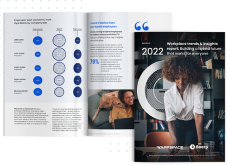
Prepare your employees for a hybrid workplace. Here's how
Larraine Solomon
April 22, 2021We're all aware that the employee landscape has fundamentally shifted. And I think it's fair to say that the ‘workplace of the future’ is on every business leader's mind right now. But the next steps in our ‘new normal’ are complicated by challenges and questions.
How will a physical/virtual enterprise work? With some employees at home, some back in the office, and others doing a mix of both, how do you keep everyone engaged? How do you make sure your hybrid workplace is an inclusive one? Join our upcoming webinar to find out.
While many organizations have been able to reduce the fixed costs associated with physical office space, the costs in terms of employee retention and long-term productivity are more difficult to determine.
Businesses are starting to report that teams have become more siloed over the last 12 months, and video conferencing fatigue is becoming a real and unsustainable threat.
Big companies are starting to notice the toll remote working is starting to take on employees. Some are taking action. LinkedIn, for example, recently announced that it's giving employees a paid week off as an opportunity to unplug, recharge, and avoid burnout. And Citigroup has created ‘zoom free’ Fridays to combat pandemic fatigue.
Should workers return to the office?
Plans to encourage workers back to the office have sparked discussion, creativity, and even controversy worldwide.
Google announced that employees will need permission to work from home for more than two weeks a year and Amazon plans to restore an “office-centric culture”.
At the other end of the scale, the world’s largest law firm Dentons will offer permanent home working, and PwC are allowing their workers to personalize their working experience.
There's no one solution.
5 ways an intelligent digital workplace can prepare your employees for a hybrid model
Research cites communication as the most important factor in making sure a proposed hybrid work model succeeds.
In practice, this means creating the best processes and technology to support transparent messaging and the ability for employees to ask questions and share their views. Both office and remote employees need equal access to work opportunities, conversations, and company news.
An intelligent digital workplace (think next-level intranet) should be at the heart of a collaborative communication approach.
Here are ways you can use your digital workplace to smooth the transition to a hybrid work model:
1. Communicate plans about post-Covid working arrangements as they evolve
Employees want to feel included in decision making, even if plans are not finalized. Use your digital workplace to frequently share what’s already decided and to communicate what's still uncertain.
2. Help senior leaders to role model your hybrid work arrangement
If all employees are expected to be in the office some of the time, use your digital workplace to profile the experience of leaders as they do the same. Leading by example goes a long way to motivate others.
3. Unlock collective intelligence
Workers will have questions and suggestions as they begin to work in a different way. Newer employees might be even be coming to the office for the first time and meeting new colleagues.
Use your digital workplace to tap into the collective knowledge of your workforce by encouraging online discussion, ideas, and observations. This could range from questions about how to comply with Covid regulations in the office, to the availability of equipment to lunch arrangements in a new environment.
4. Make sure home workers feel like an integral part of the team
Most employees are used to connecting with friends and colleagues using social media outside of work. In a similar way use your digital workplace as a virtual ‘water cooler’, providing the perfect platform to collaborate and communicate with colleagues wherever their location.
With easy-to-use social features such as discussion forums, polls, comments, crowd-sourcing, @mentions and translation, your digital workplace can ensure that nobody feels left out.
5. Support remote and office onboarding
Make sure all new employees have a consistently good experience when they join. Your digital workplace should play host to introductory videos and training materials which will encourage an instant connection with your organization. Videos, messages and connections with team members will help to create a welcoming team environment.
What are some practical steps you can take to create a successful and inclusive hybrid workplace?
Watch our on-demand webinar where we discuss:
- How business leaders can develop a highly successful and inclusive hybrid workplace
- The role an intelligent digital workplace can play in creating a work environment where everyone thrives


